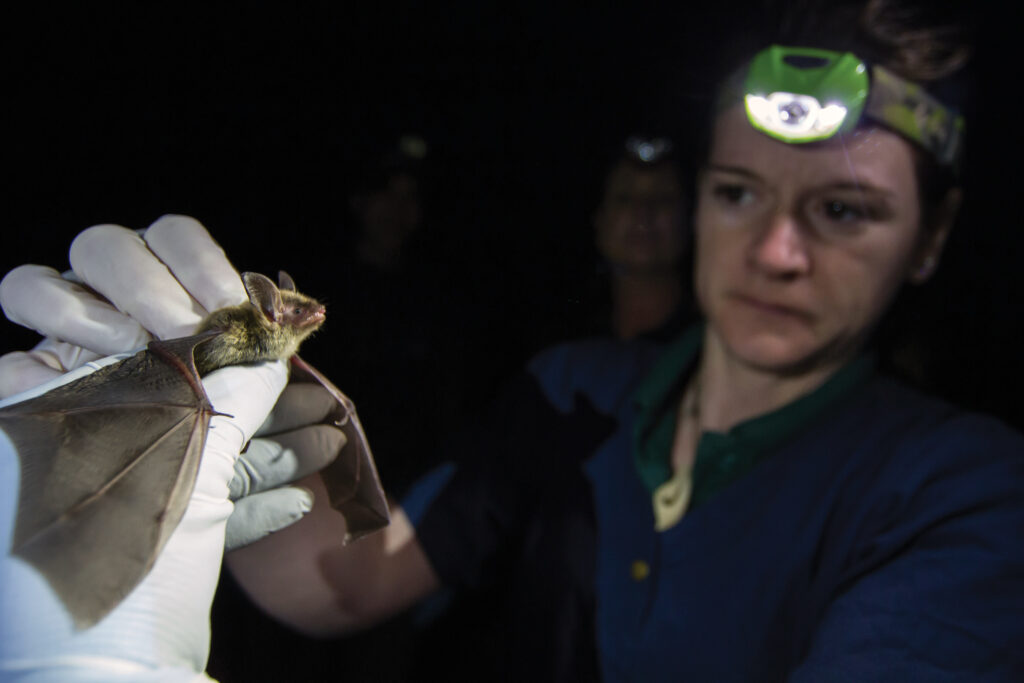
Toward the end of October, Halloween-themed bats of all shapes, sizes and personas will begin to appear on our sidewalks and front door stoops. Their real-life counterparts, however, have been whirling over our heads for months.
According to Wes Stone, associate professor of wildlife ecology at Alabama A&M University, 16 confirmed bat species call Alabama home for at least part of each year. While they are present from spring through fall, we often notice bats more this time of year because they are quite busy gorging on beetles, moths, mosquitoes and other night-flying insects in preparation for winter hibernation or migration.
When these winged mammals, the only mammals that truly fly rather than glide, take to the skies at dusk, they may strike fear in the hearts of people who view bats as spooky, hideous creatures of the night. But for Stone and other chiropterologists (bat biologists) they are to be admired — cute, fuzzy (some say cuddly) creatures that nurture their young and other members of their colonies while also supporting humankind.
As bats consume huge numbers of insects each night (up to 100 percent of their bodyweight in insects at times) they provide an estimated $3 million in pest control services across the U.S. Bats also help pollinate or spread the seed of more than 500 flowering plants worldwide — without them we might not be able to enjoy such delicacies as chocolate, tequila, figs or mangos.
And while bats can harbor rabies, Stone said they rarely transmit it, nor do they attack or suck the blood of humans so there is little to fear from these fascinating creatures. Yes, errant bats can wander into our homes and colonies of bats will set up housekeeping inside homes and offices, which can be problematic for people and bats. But if this happens, Stone said there’s no need to panic because bats can be safely removed and excluded without harming people or bats.
Bats may pose little threat to us, but they are under threat from a variety of factors. Things like habitat loss, destruction of roosting sites, overuse of pesticides, water pollution and the spread of a fungal disease (white-nose syndrome) are imperiling bat populations worldwide, including here in Alabama, where three species (Indiana, gray and northern long-eared bats) are listed as Threatened or Endangered by the U.S. Fish and Wildlife Service. Others are categorized as high conservation concerns.

“They play a key role in nature, and we won’t appreciate it until they are gone,” Stone says of the bats he studies in his job at AAMU and as a member of the Alabama Bat Working Group. The ABWG is a coalition of people and organizations from across the state and region that work together on bat research, monitoring and educational programs such as the annual Bat Blitz. This annual summer event, held in a different area of the state from one year to the next, brings bat researchers together to assess local bat populations, information that helps guide conservation strategies.
Everyday folks (citizen scientists) can go to bat for bats play by reporting bat activity in their neighborhoods, volunteering to help with research and education efforts and by making their yards and neighborhoods more bat friendly. (See options at batcon.org/wp-content/uploads/2022/04/Guide-to-Gardening-for-Bats.pdf.) Larger landowners can also help by preserving caves, rocky outcroppings, trees (living and dead) and other roosting or hibernation sites on their properties.
Of course, we can all appreciate them from afar by standing outside in our yards as they swoop and dart in the sky at dusk or watching a bat cauldron (the term used for a large group of bats concentrated in a specific area) emerge, 60,000 to 250,000 at a time, from caves and other roosting sites. This spectacular event can be witnessed at several locations in Alabama each summer: Go to outdooralabama.com/nongame-wildlife-program/bat-watching-alabama to learn more.

Information about Alabama’s bats, including links to bat removal resources, is available at the ABWG site (alabamabatwg.wordpress.com), through the Alabama Department of Conservation and Natural Resources (outdooralabama.com) and at Bat Conservation International (batcon.org). Contact the Alabama Department of Public Health (alabamapublichealth.gov) or your county health department office for advice on safely handling, removing and testing sick or dead bats.
Katie Jackson is a freelance writer and editor based in Opelika, Alabama. Contact her at [email protected].




